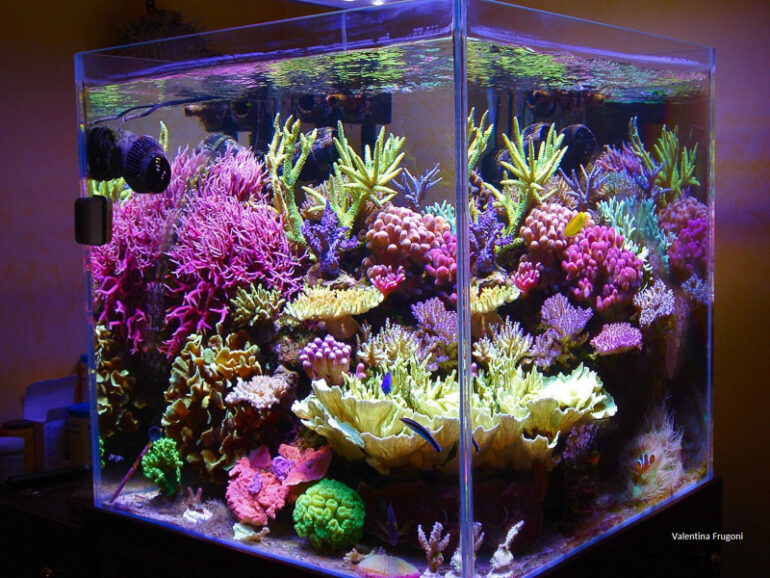As I have mentioned numerous times in the past, I consider myself to be a lucky person. And one of the ways this luck has manifested itself, is that I have been fortunate to get to see one of my main passions in life: reef tanks, all around the world.
While visiting Italy last month, as is usually my custom, I visited numerous shops and homes and got to see lots of what I consider to be beautiful reef tanks. While I did not see any quite as elaborate as those of David Saxby, or Martin Lakin in Italy, I did see enough to know that the passion that the Italians show for most things in life is also shown in their reef tanks.
They seem to have a gift for taking something simple like pasta or a piece of fish and make it into one of the best things you have ever eaten, and many take this concept of simplicity and apply it to their tanks. While visiting several towns and villages during my visit and getting to view structures that have been around for centuries it quickly became clear that in Italy longevity as well as beauty is one of the things they try to achieve when they do something.
As I pointed out in my last article, disposable income in Italy is significantly less than here in the states. Nonetheless, from what I saw, the Italians spend money on every aspect of the hobby with the goal seeming to be that when a tank was set up, it was set up to last a long time.

In this regard, I did not see any scrimping when it came to having good equipment and great corals in seemingly every tank. I know I was spoiled in that I was probably only taken to see the best tanks, but while I was at the Pet Fair, many hobbyists also showed me pictures of their tanks and these were equally impressive.
The first impressive Italian tank was owned by Alvaro Acierno, and to me typifies the Italian knack for blending the colors of the corals so that they are very pleasing to the eye. His tank was up for approximately 2.5 years when the photographs were taken and as with most of the tanks I saw it was started with only frags and small colonies, both wild and maricultured.
As can clearly be seen from the pictures it is run on by the ultra low nutrient method using Fauna Marin products exclusively. While tanks run by this method are generally not the way I would go, I have to admit that the colors of the corals were
spectacular and they looked incredibly healthy with no discernible dead spots
or algae anywhere in the tank.
Alvaro was happy to talk about his tank and it was clear that he took a great deal of time to both set it up and maintain it, but that like most things I had seen the Italians do, it was done with passion and he took great pride in trying to keep it perfect. Like many tanks I saw there it was lit with a combination of t-5s and LEDS.
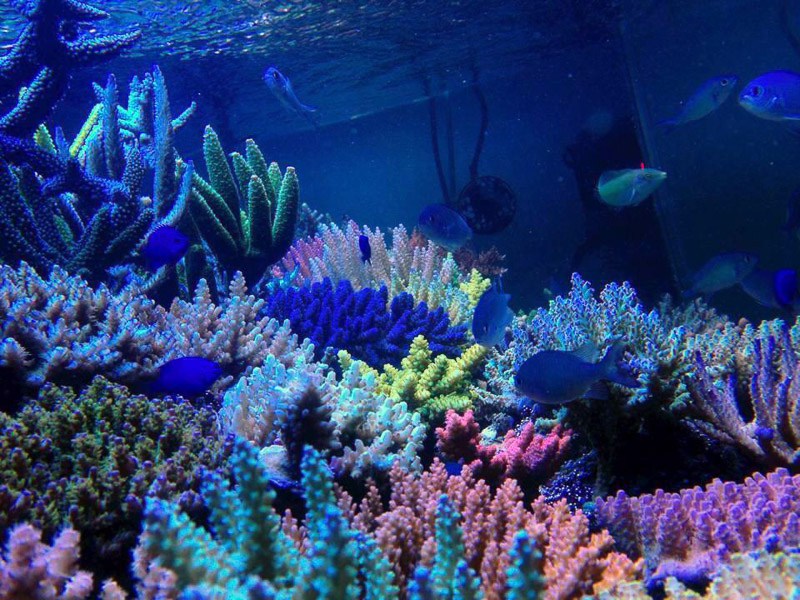
I had not seen many tanks run on this combination of lights here, but in Italy it seemed to be how lighting was changing as they too were moving away from metal halides. The only aspect of the tank that I missed was that it did not have a lot of fish in it. This is just my personal opinion and in no way detracts from the beauty of the tank.
This tank was an introduction to how the Italians use color and plan to maximize its impact when they set up a tank. From my perspective it looked a bit subdued although quite attractive, compared with halides or the LEDs that I have now grown used to. But when looking at the health and coloration of the corals it was readily apparent that it was working and obviously is a good way to light a tank and optimize coloration from both.
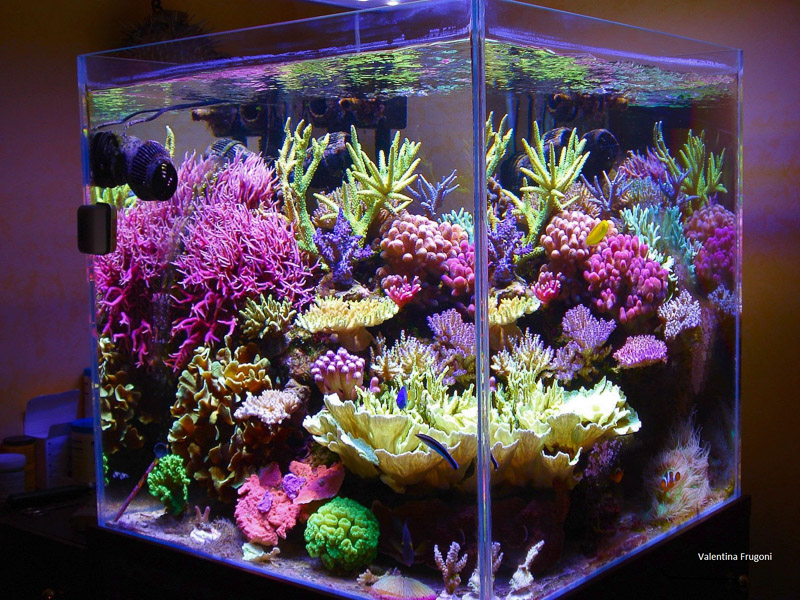
in a similar vein, the tank of Alvaro’s wife, Valentina, was a 60cm (2foot) cube that was also set up to demonstrate how the harmonious blend of color should be planned for when setting up a tank. To me this tank was impressive for several reasons.
First, even though it was relatively small in size it still was quite visually stunning as like Alvaro’s tank it blended the pastel colors of the corals in such a way that it can only be described harmonious. That is when you looked at the tank, if even for a short period, you couldn’t help but feel relaxed.
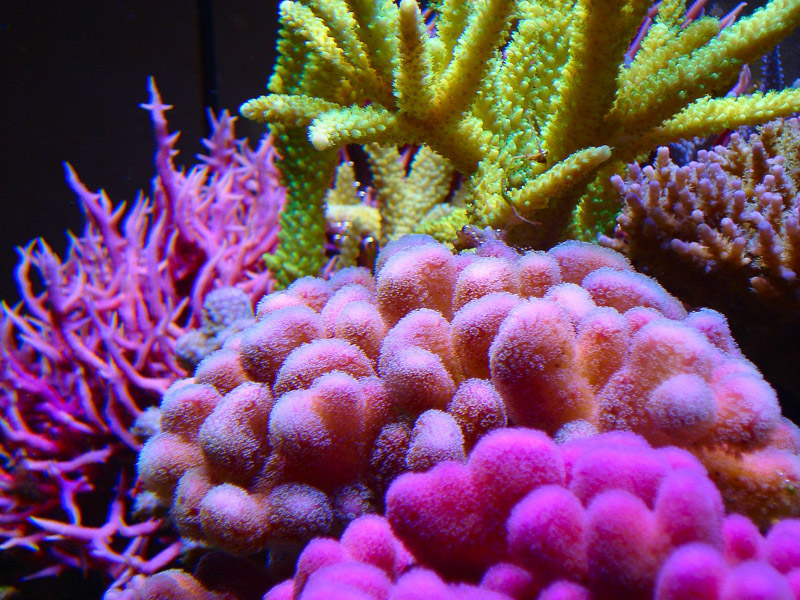
And lastly this tank impressed me because unlike many tanks lit by LEDs, this tank showed off the pink corals better than any other tank I have seen lighted by LEDs. I don’t know if it is because her LEDs only utilized blue and white or because she was trying to improve colors by manipulating trace elements, but she seems to have accomplished her goal if it was to maximize color in her
corals, especially if they were pink.
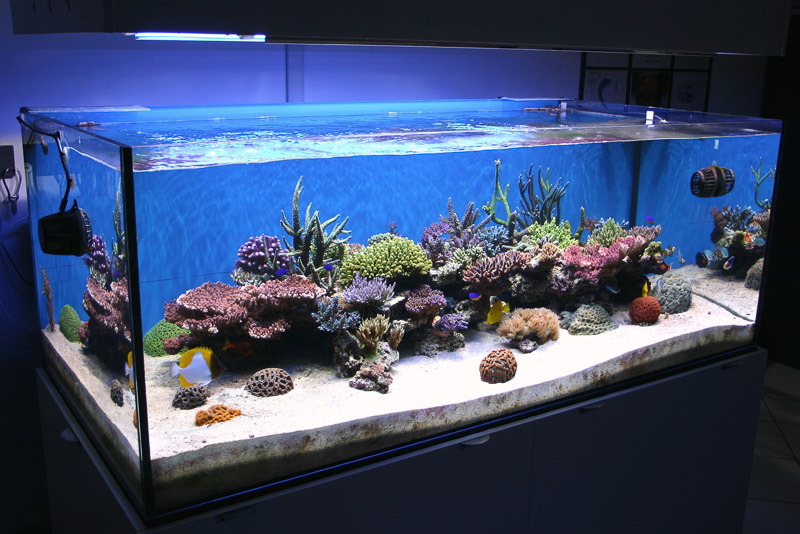
The next tank is a relatively new tank at only 1 ½ years of age, but the growth and coloration of the corals is still impressive. This tank is owned by Paolo Piccinelli. It is the only tank I saw that was still lighted by metal halide lamps and Paolo is old school as he was running 10K lamps.
These were augmented by blue t-5, and all of the light is focused to the center of the tank as Paolo designed the tank to be seem from three sides so all of the corals are in the center in a modified bommie set up. Most of the corals in this tank were started from either frags or very small colonies and by using high growth low Kelvin lights and augmenting the tank withTropic Marin trace elements and using a homemade calcium reactor to keep the alkalinity fairly high, Paolo has gotten significant growth in his corals and good coloration.
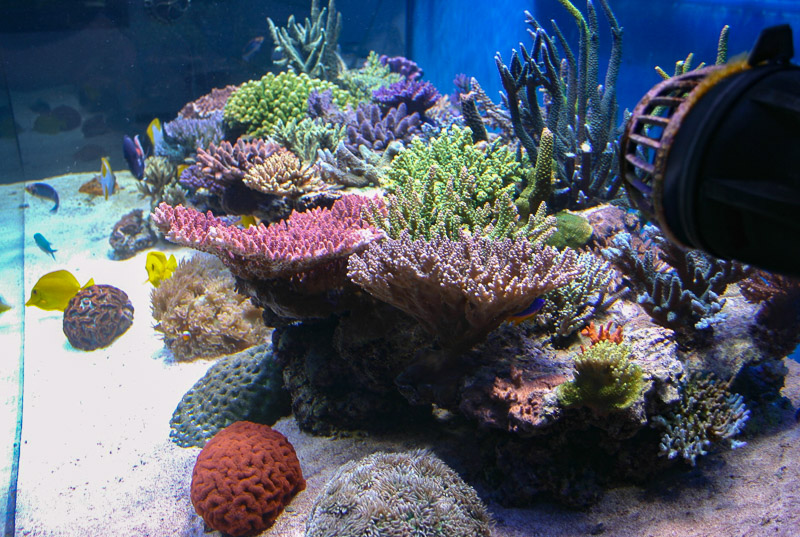
I think it is interesting to note that his use of a deep sand bed rather than a reactor or chemicals helps keep the nutrient levels in his tank low. But unlike the previous two tanks which used LEDs and higher temperature t-5s, even these low nutrient levels did not produce colors in the corals like the other tanks. To me at least, this is further confirmation of how much blue light or higher temperature light can impact the colors of corals.
The first three tanks that I wrote about are to me what I would describe as typical Italian sps tanks. That is they were quite healthy, colorful, did not contain a ton of fish and the shapes and colors of the corals wereplaced such that the tank was enjoyable to look at. These tanks all kept the fish load and the nutrient levels low and the colors shown in the pictures is what occurs in this type of system.
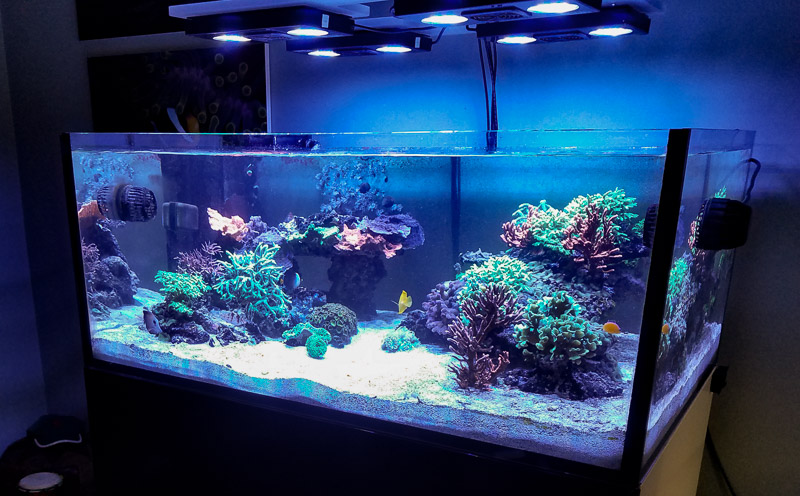
The next two tanks on other hand have significantly higher fish loads and as a result higher nutrient levels. These tanks are also dear to my heart for different reasons that I will discuss. The first of these is owned by Roberto Spinoglio and is a tank
I have wanted to do myself for the past couple of years.
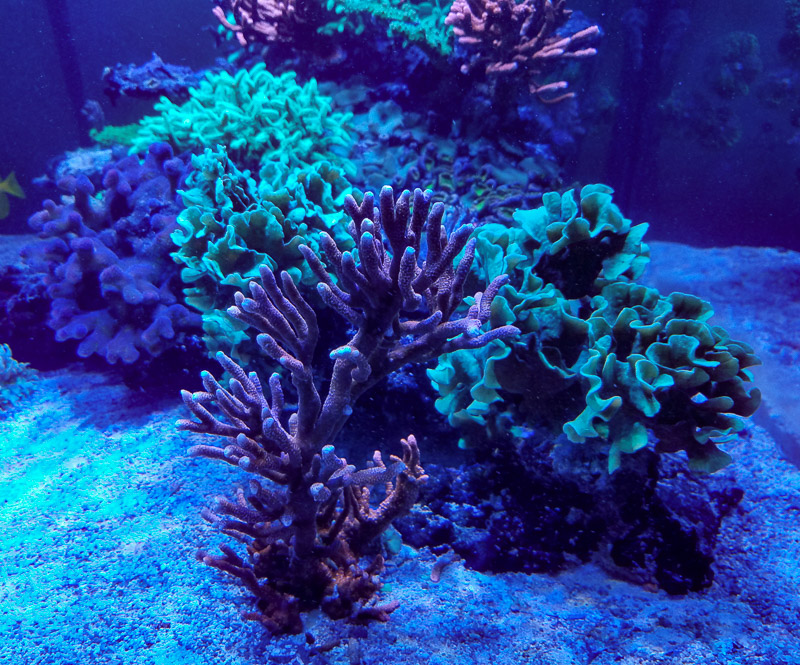
On first glance it just looks like a typical sps tank. But on closer inspection it is clear that it is unique, at least from other sps tanks I have seen in that it contains no Acropora. Instead it is filled with colorful Montiporas of various colors and growth forms as well as Seriatoporas, Stylophoras and a large colony of Pavona. Despite the absence of the seeming hallmark of an sps tank, Acropora, I think this tank is as appealing as any sps tank I have seen. It also has a deep sand bed and houses tangs, angelfish, clownfish several other small fish.
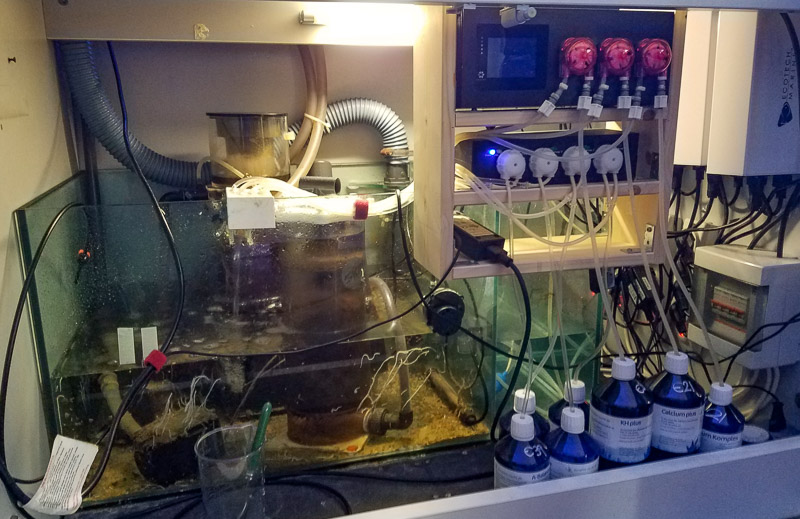
Since Roberto travels quite a bit he has automated it as much as possible in that he uses multiple dosers to feeding in various Zeo products to keep the water chemistry stable and like most of the tanks I saw in Italy it too was initially filled with small frags, which were allowed to grow out.
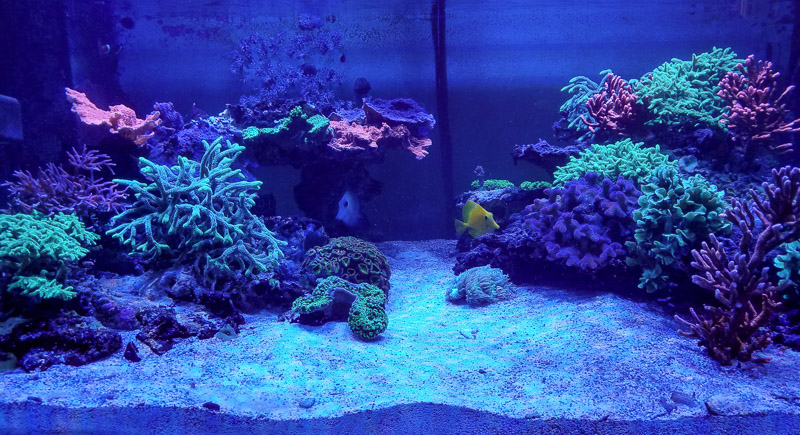
The tank was also a bit unique as well as it was the first tank I saw in Italy using only Radion LED fixtures to light the tank. Roberto uses a custom designed template on the Radions to maximize the coloration of the corals. And from my perspective the tank was at least as colorful as any I have seen where Acropora dominate.
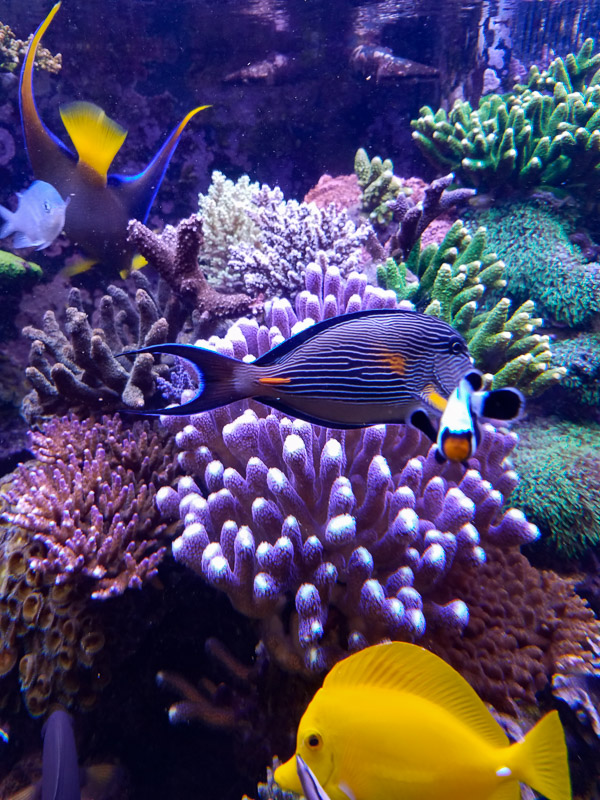
The final tank I saw was also the largest I saw while I was visiting. This tank was owned by Enrico Ometto and serviced by Mauro Reniero of the shop Agrizoo. This tank was impressive for a number of reasons. The first of which was due to it’s size. It is over 800-gallons in size and had over a 200-gallon sump/refugium.
In this refugium are two inches of Miracle Mud as well as a thriving assortment of Caulerpa in the mud. This was the first such tank I saw set up this way in Italy. If this were the only unique thing about this tank, that would have been enough, but it also housed a beautiful collection of large colonies of corals, which for the most part were flawless and showed the customary great polyp extension as often occurs in Miracle Mud based tanks.
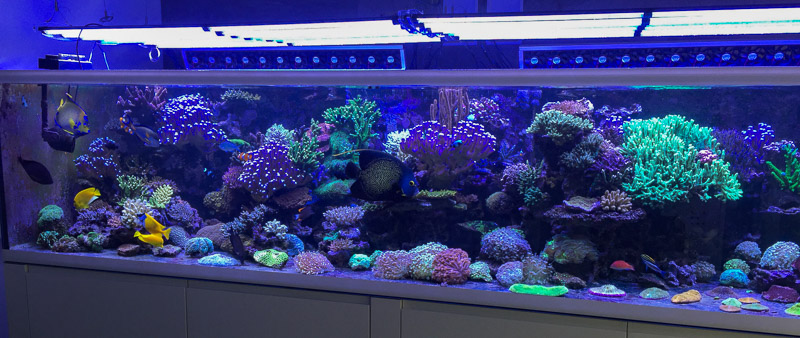
This polyp extension was even more impressive when I noticed that the tank houses a flawless adult French Angelfish, as well as a Queen Angel and Tricolor Angel, all of which are known for picking at sps corals. All of the fish as well as the corals were
grown out in this tank to their current size in less than 2 ½ years, which again is impressive. The lighting while nice, was not overwhelming, as it consists of a bank of blue and white LEDs, that virtually cover the entire top of the tank.

If it were just the size of the tank and the large mud refugium, the interesting angelfish population and the large colonies of healthy corals this tank would have been worth seeing and writing about. But what really made it unique for me is that it utilized a piece of equipment that I had never seen before.
Next to the tank sat a device that is an automatic zooplankton and phytoplankton feeder. That is, this tank has zooplankton and phytoplankton dumped into it nightly, and automatically from a reactor that does it all without Enrico or Mauro having to do anything.

Needless to say I was intrigued by this concept, as I have been considering growing zooplankton for a while and adding it to my tank on a regular basis, but had not seen a tank that was doing this to convince me. After seeing this tank, the health of the fish and corals with their impressive polyp extension I am convinced that doing this can be the next step in improving what we or at least I am doing without adding significant effort.
Getting to visit new locales and seeing beautiful tanks done in all kinds of different ways using equipment I have never seen is still an exciting part of the hobby for me. While I love seeing beautiful corals, I have to admit that seeing new interesting equipment in use for the first time is also still exciting.
Fortunately for me, my trip to Italy provided me the opportunity to see both.


